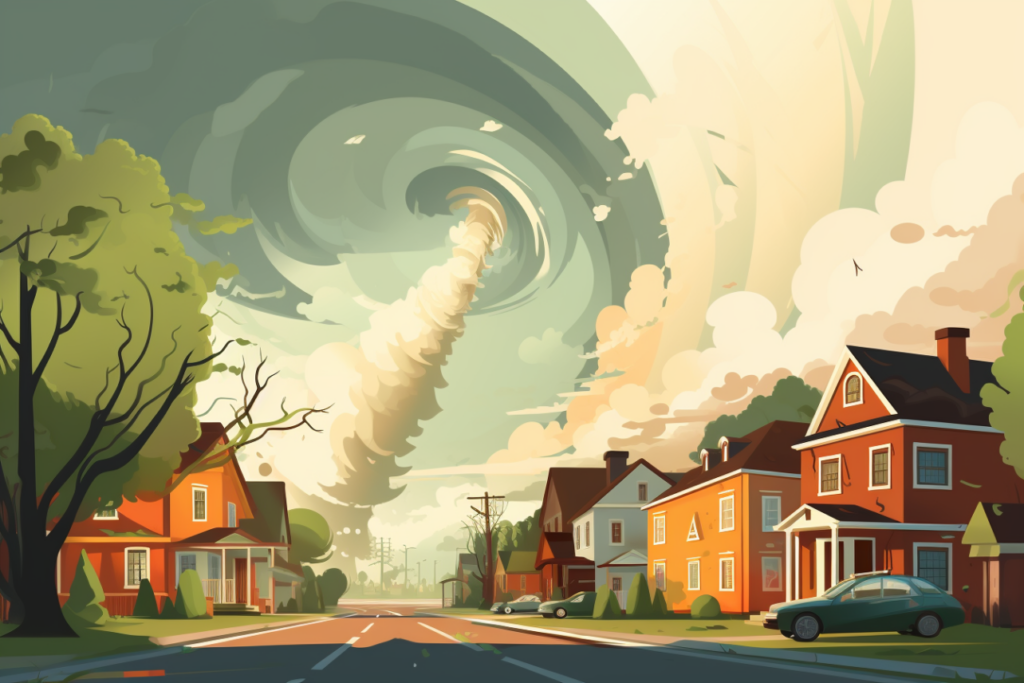Tornadoes are among nature’s most violent phenomena. With little warning, they can tear through communities, leaving a trail of destruction in their wake. Tornadoes are formed through a complex interaction of atmospheric conditions, most often due to severe thunderstorms called supercells. Understanding the dynamics of tornado formation is complex and is still a subject of extensive meteorological research.
But knowing what to do when one strikes could mean the difference between life and death. And that is something we can help prepare you for in case it happens.
Where are Tornadoes Generally An Issue?
Tornadoes can occur all over the world, but they are most common in the United States, particularly in an area known as “Tornado Alley.”
This region in the central United States that includes parts of:
- Texas
- Oklahoma
- Kansas
- Nebraska
- South Dakota
- Iowa
- Missouri
- Colorado
- North Dakota
Apart from Tornado Alley, the Southeastern United States, notably the area known as “Dixie Alley” which includes parts of:
- Alabama
- Mississippi
- Georgia
- Tennessee
This area is also known for a high frequency of tornadoes, some of which can be particularly violent and occur outside the traditional spring season.
It’s important to note that while these regions are known for their frequent tornadoes, these natural disasters can occur almost anywhere under the right conditions.
Tips for Staying Safe During a Tornado

Here are ten crucial tips for staying safe during a tornado:
1. Understand the Warnings
Know the Difference:
- Tornado Watch: Refers to the conditions being favorable for a tornado to develop, but one has not been seen.
- Tornado Warning: This is when a tornado has been sighted or indicated by weather radar.
2. Have a Plan
Create a Safety Plan and identify a safe place in your home, like a basement or an interior room (closet) on the lowest floor, away from windows. If you live in an area known for tornados, practice tornado drills with your family. And always have an emergency kit ready.
3. Stay Informed
- Use a battery-operated weather radio or a smartphone app for live updates.
- Pay attention to weather alerts and emergency instructions from local officials.
4. Seek Shelter Immediately
Head to your predetermined safe place without delay. If you’re in a building without a basement, find the center of an interior room on the lowest level (closet, hallway), away from corners, windows, doors, and outside walls.
5. Protect Yourself from Debris
Use heavy furniture and blankets to protect yourself from flying debris.
6. If You’re Outside or in a Vehicle
If you can get to a sturdy building safely and find cover, do so immediately. If there is no shelter nearby, drive to the closest sturdy shelter. If extreme winds and flying debris catch you, park the car and stay below the level of the windows, covering your head with your hands.
7. Avoid Windows
Do not open windows. Use the time to get to safety. Keep away from glass that can shatter and cause injury.
8. After the Tornado Passes
Be cautious and await official word that the danger has passed before emerging. Watch out for fallen power lines, debris and broken gas lines.
9. Check for Injuries
Never move seriously injured people unless they are in immediate danger. Administer first aid as necessary.
10. Inspect Your Home
When entering a damaged building, be cautious of unstable structures and flooding.
Use a flashlight to inspect for damage if the power is out, and wait for first responders if you are uncomfortable entering your home to inspect the damage.
How to Prepare for a Tornado
When it comes to tornado preparedness, many people have questions about protecting themselves, their loved ones, and their property. Here are some frequently asked questions about preparing for a tornado:
How Do I Know if a Tornado Is Likely to Occur?
Pay attention to weather alerts issued by the National Weather Service (NWS). Also look for signs and be aware of the weather conditions often preceding a tornado, like a dark or green-colored sky, a large, low-lying cloud.
Should I Open Windows to Equalize Pressure During a Tornado?
No, this is a myth. Opening windows does not help and can waste valuable time. The most important action is to take cover immediately.
What Should I Include in My Emergency Kit for a Tornado?
A proper emergency kit will have water, non-perishable food, a battery-powered or hand-crank radio, a NOAA Weather Radio with tone alert, extra batteries, a first aid kit, necessary medications, a multipurpose tool, personal hygiene items, copies of personal documents, cell phone chargers, emergency contact information, blankets or sleeping bags, and cash.
Can I Stay in My Car During a Tornado?
No, cars are not safe during tornadoes. If you are in a vehicle and cannot safely drive to a sturdy shelter, your next best option is to get down in your car and cover your head.
How Can I Protect My Pets During a Tornado?
Include your pets in your emergency plan. Have a pet emergency kit ready, and know where you can take your pets if you need to evacuate. Keep them on leashes or in carriers during a tornado warning, and bring them to your safe place.
How Can I Help My Community Prepare for a Tornado?
You can help your community by educating others about tornado preparedness, participating in community emergency planning and drills, and encouraging the installation of community storm shelters.
Conclusion
Preparation and prompt action are key to surviving a tornado. Following these tips can better protect yourself and your loved ones when faced with such a terrifying event. Remember, no property is worth more than your life. Safety comes first, always.
You might also be interested in: 11 Tips To Prepare For Power Outages




